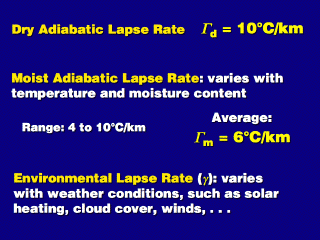 If we adiabatically expand a saturated air parcel, the temperature
will decrease but this then produces a supersaturated condition (the temperature
has dropped below the dew
point). Condensation will then take place; the latent
heat released will warm up the parcel ("sensible" heat, the kind
that changes temperature if transferred, has been added). This warming partially
offsets the loss of temperature due to adiabatic expansion. Because of the
conversion of latent heat into sensible heat, the process is not truly adiabatic.
However, we don't let the released latent heat escape from the parcel, so the
process is close to a truly adiabatic one.
If we adiabatically expand a saturated air parcel, the temperature
will decrease but this then produces a supersaturated condition (the temperature
has dropped below the dew
point). Condensation will then take place; the latent
heat released will warm up the parcel ("sensible" heat, the kind
that changes temperature if transferred, has been added). This warming partially
offsets the loss of temperature due to adiabatic expansion. Because of the
conversion of latent heat into sensible heat, the process is not truly adiabatic.
However, we don't let the released latent heat escape from the parcel, so the
process is close to a truly adiabatic one.
The process is reversible if we keep
the condensed droplets inside the parcel. Compressing
the parcel raises the temperature and causes the droplets to evaporate,
re-absorbing the previously released latent heat (so the gain of temperature
through adiabatic compression is partially offset by the cooling effect of the
latent heat absorption), and thus the final temperature will be the same what
we started with.
 The dry adiabatic lapse rate gives us the loss of temperature
vs. increase in altitude for an unsaturated air parcel. It is fixed at
10 C/km in the Earth's troposphere by the composition of the air and
the strength of the Earth's gravitational field.
The dry adiabatic lapse rate gives us the loss of temperature
vs. increase in altitude for an unsaturated air parcel. It is fixed at
10 C/km in the Earth's troposphere by the composition of the air and
the strength of the Earth's gravitational field.
The moist adiabatic lapse rate
is used to describe the temperature of a moving parcel when it is saturated.
It is less than the dry adiabatic lapse rate because the condensation heating
offsets some of the temperature loss due to "dry" adiabatic expansion,
as seen above. The amount of condensation taking place will determine how much
of this offset is produced, and hence result in different values for the moist
adiabatic lapse rate: when the air temperature is relatively high, the vapor
pressure is relatively high (the air is saturated, and at high temperatures,
the saturation vapor pressure, which will be equal to the vapor pressure, is
high) and the rate of condensation will be relatively high; therefore, the amount
of offset heating is high, and we have small moist adiabatic lapse rates (around
4C/km).
The environmental lapse rate is
a whole different thing from the adiabatic rates. The adiabatic lapse rates
refer to temperature inside an air parcel that is rising or sinking. The environmental
lapse rate comes from the variation of the ambient air temperature with altitude.
There is no thermodynamic process controlling the environmental temperature;
the sun, the wind, clouds, moisture, etc. will affect the environmental temperature
and therefore the environmental lapse rate. An average environmental lapse
rate for the troposphere is 6.5C/km (which is suspiciously close to the
average moist adiabatic lapse rate for parcels).



 If we adiabatically expand a saturated air parcel, the temperature
will decrease but this then produces a supersaturated condition (the temperature
has dropped below the dew
point). Condensation will then take place; the latent
heat released will warm up the parcel ("sensible" heat, the kind
that changes temperature if transferred, has been added). This warming partially
offsets the loss of temperature due to adiabatic expansion. Because of the
conversion of latent heat into sensible heat, the process is not truly adiabatic.
However, we don't let the released latent heat escape from the parcel, so the
process is close to a truly adiabatic one.
If we adiabatically expand a saturated air parcel, the temperature
will decrease but this then produces a supersaturated condition (the temperature
has dropped below the dew
point). Condensation will then take place; the latent
heat released will warm up the parcel ("sensible" heat, the kind
that changes temperature if transferred, has been added). This warming partially
offsets the loss of temperature due to adiabatic expansion. Because of the
conversion of latent heat into sensible heat, the process is not truly adiabatic.
However, we don't let the released latent heat escape from the parcel, so the
process is close to a truly adiabatic one. The dry adiabatic lapse rate gives us the loss of temperature
vs. increase in altitude for an unsaturated air parcel. It is fixed at
10 C/km in the Earth's troposphere by the composition of the air and
the strength of the Earth's gravitational field.
The dry adiabatic lapse rate gives us the loss of temperature
vs. increase in altitude for an unsaturated air parcel. It is fixed at
10 C/km in the Earth's troposphere by the composition of the air and
the strength of the Earth's gravitational field.